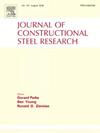开发并验证了螺栓角夹板弯曲全范围响应计算模型
IF 4
2区 工程技术
Q1 CONSTRUCTION & BUILDING TECHNOLOGY
引用次数: 0
摘要
本文研究了通常用于钢结构框架的梁柱连接的螺栓式角钢铰的全方位性能。采用四种不同的结构形式,对螺栓连接的角夹板进行了8次弯曲试验。建立了互补的有限元模拟模型,其中包括一种韧性断裂模型,称为Lode角修正空隙生长模型(LMVGM)。所提出的有限元模型能有效地捕捉角剪在多轴应力和塑性应变作用下的开裂情况。试验和有限元分析结果表明,柱、梁法兰连接角支腿(分别称为柱支腿和梁支腿)的螺栓规尺寸影响断裂位置,螺栓规较大的柱或梁支腿内形成的塑性铰线内容易发生断裂。具体来说,螺栓规尺寸是指柱腿或梁腿上的角跟和螺栓孔中心之间的距离。此外,在塑料铰链中观察到角板厚度的可测量减少(最多减少14%),这是由于在大变形下每个腿的横向拉伸膜作用导致的高拉伸应力的存在。基于试验观测和有限元模拟,提出了一个预测角剪全范围性能的理论模型。该理论模型考虑了塑性弯曲机制的逐渐形成、材料屈服引起的非线性响应和大变形响应(膜作用)、板铰局部塑性流动导致的板厚和抗弯强度降低以及螺栓滑移。所提出的模型使用本文提出的角度清晰度测试进行了验证,显示出比en1993 -1-8中编写的模型更好的准确性。提出的模型被纳入广义分量法来模拟已公布的螺栓角连接试验的力矩-旋转响应。与采用现有角度清晰模型的广义分量法分析相比,该模型提供了更精确的响应曲线。本文章由计算机程序翻译,如有差异,请以英文原文为准。
Development and validation of a model to calculate full-range response of bolted angle cleats in bending
This study investigates the full-range behaviour of bolted angle steel cleats, commonly used in beam-column connections of steel structural frameworks. Eight experiments were conducted on bolted angle cleats in bending with four different configurations. Complementary finite element simulation models were developed, incorporating a ductile fracture model, termed Lode angle modified void growth model (LMVGM). The proposed finite element model effectively captures cracking in the angle cleats under multi-axial stresses and plastic strains. Test and finite element analysis results showed that the bolt gauge dimensions of the legs of the angle connected to the column and beam flanges (referred to as the column leg and beam leg, respectively) affect the fracture location, which tends to initiate within the plastic hinge line that forms in the column or beam leg with the larger bolt gauge. Specifically, the bolt gauge dimension refers to the distance between the angle heel and bolt hole centre on either column or beam leg. Additionally, a measurable reduction in the angle plate thickness (up to 14 % reduction) was observed in the plastic hinges due to the presence of high tensile stresses resulting from the tensile membrane action developed in the transverse direction of each leg under large deformations. Based on observations from the tests and finite element simulations, a theoretical model is proposed to predict the full-range behaviour of angle cleats. The theoretical model incorporates the gradual formation of a plastic bending mechanism, nonlinear response due to material yielding and large-deformation response (membrane action), reductions in plate thickness and bending strength due to local plastic flow in the plate hinges, and bolt slippage. The proposed model was validated using the angle cleat tests presented herein, showing substantially better accuracy than the model codified in EN 1993-1-8. The proposed model was incorporated in the Generalised Component Method to simulate the moment-rotational responses of published bolted angle connection tests. The proposed model is shown to provide more accurate response curves compared to Generalised Component Method analyses that employ existing angle cleat models.
求助全文
通过发布文献求助,成功后即可免费获取论文全文。
去求助
来源期刊

Journal of Constructional Steel Research
工程技术-工程:土木
CiteScore
7.90
自引率
19.50%
发文量
550
审稿时长
46 days
期刊介绍:
The Journal of Constructional Steel Research provides an international forum for the presentation and discussion of the latest developments in structural steel research and their applications. It is aimed not only at researchers but also at those likely to be most affected by research results, i.e. designers and fabricators. Original papers of a high standard dealing with all aspects of steel research including theoretical and experimental research on elements, assemblages, connection and material properties are considered for publication.
 求助内容:
求助内容: 应助结果提醒方式:
应助结果提醒方式:


